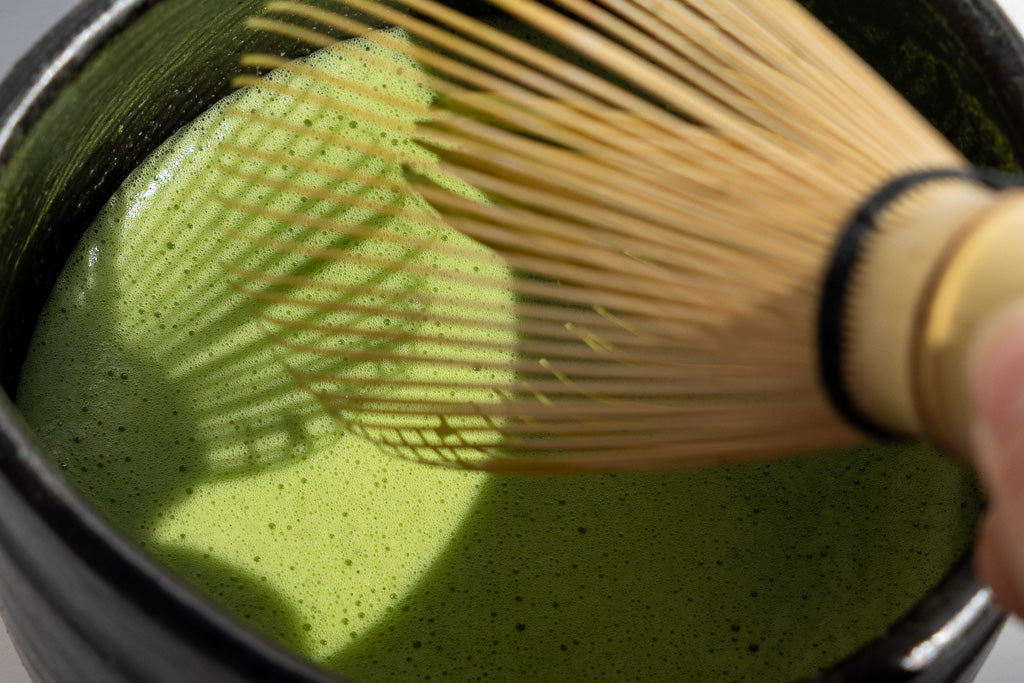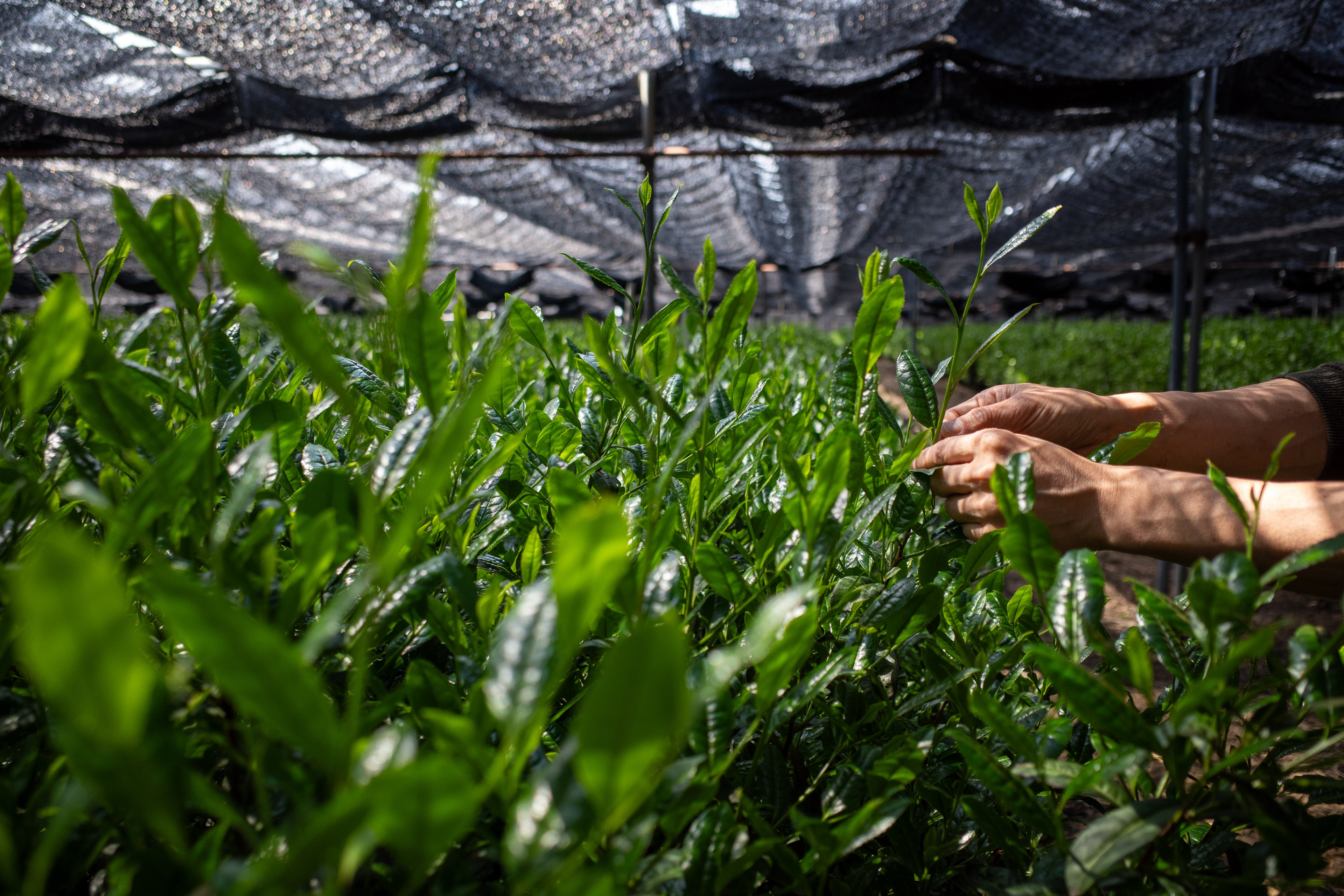Written by a mindfulness tea teacher, Miki Sensei.
In sado (the Way of Tea), there is a curious distinction in how we describe the act of preparing tea. For sencha, black tea, or any tea where leaves are steeped, we say ireru (“to brew,” written 淹れる). But for matcha alone, we say tateru (“to whisk,” written 点てる).
The word tateru in this sense is used almost exclusively for matcha, so even in Japan, not everyone may know how to read or use this term.
What exactly does tateru mean? And why is it usually translated into English as “whisk”? Let’s pause to consider the depth of this word.
The Origin of "Tateru" and Its Meaning
The word uses the character 点 (ten). Some say that the character ten only came into use from the late Edo period, during the time of the feudal lord Ii Naosuke in the early 1800s. Before that, the homonym 立てる (tateru, “to stand, to raise”) was used. There was already a distinction from ireru 淹れる, to brew tea. From the meaning and sound alone, we sense a spirit of tatematsuru (奉る), to revere, offer, with respect.
Why then was 点 (ten) chosen, and why has it endured until now? And why do we call the entire sequence of preparing and putting away the tea utensils o-temae?
The character 点 carries many meanings, tracing back to ancient Chinese divination with turtle shells, meaning
- a mark, a sign
- a result, an outcome
- to light, to ignite
- to pour
- to touch, to intersect
Resonance of 点 (ten) in Tea and Life

Here lies a hint.
From a quantum perspective, this world is made of both particles (points) and waves. What flows as a wave can, when observed with focus, appear as a point. And that point is never static; it is constantly trembling.
Time, seasons, and life itself are impermanent lines, and each fleeting moment is a point. Each point is a process, yet also contains the whole.
It is where tea and hot water, host and guest—separate beings—meet in a single space. At that point, awareness, spirit, and energy are lit, however briefly, to shine brightly and illuminate those around.
In this sense, we notice how much the meaning of 点 (ten) underlies what we experience in the tearoom.
It cannot be captured in a single phrase (you truly must experience it), but if I were to put it into words, perhaps tateru means this:
To continually raise awareness of care and respect in each fleeting moment, each breath, each movement, illuminating and expanding the encounter. It is both intention and attitude, a mindfulness carried into action.
Beyond "Whisking"
Another question: Is tateru appropriate to be translated as “to whisk”?
By now, after reading the meaning of tateru, don’t you feel like exclaiming, “No way!”
“Whisk” simply means “to froth.” If I had to translate it, even partially, the word harmonize comes to mind.
In Japanese cuisine, there is aemono (dressed dishes), which culinary expert Doi Yoshiharu once explained as different from “mix” or “mélange.” In aemono, each element is enhanced through coexistence and defined through harmony. I believe that same spirit is alive in tateru of tea making.
When someone prepares tea for the first time, they often struggle to create foam. But matcha is not about frothing. It is a seamless act: tea and hot water, the host’s hand holding the whisk, all becoming one and offered to the guest.

To me, fixating on making the foam and thinking “I need it to froth!” while making tea is a distraction. True tateru comes when gratitude fills you: the awe of having tea, water, and boiling water, for the bowl and the whisk, for the person (or yourself) with whom you share the moment.
In that gratitude, the ego dissolves. Only then does a pure and delicious bowl emerge, where every ten (“point") gathers into one, and we, too, may taste becoming part of nature itself.
How to Make the Most Delicious Matcha
Different tea schools teach different ideals of a “good” bowl of matcha: how it should taste, how the tea should look. But the spirit is the same. Why we whisk, and what we find beautiful or delicious in tea, may differ, but the essence is shared.
While manuals are helpful, I encourage you to experiment and find the water temperature, tea measure, tearoom setting, bowls, and utensils that allow you to make delicious tea.

Most importantly, it is your own state of being that creates the tea itself. So first, settle yourself. Let me share with you what may be the least written guide to preparing the most delicious tea, right here and now.
Stretch a few times, and take deep breaths.
Envision the tea you want to prepare for the person before you, or for yourself. Soft, gentle, embracing? Or lively, refreshing, and uplifting?
Then embody that state yourself. With each breath, let yourself become that tea. Once you are entirely in that state, then make the tea. If you are gentle, move gently. If lively, move with vigor.
That tea, exactly as you are, will appear in the bowl.
In truth, tea training itself is a process of learning this mindful embodiment through form and practice.
May you continue to find joy in refining your own form of tea: a bowl that can only be made in this very moment, here and now.
Written by:
 |
Miki Fujisaki hibana to bloom founder, mindfulness tea facilitator/coach Website: https://www.hibana-to-bloom.com/ Instagram: @hibanatobloom |
Miki was born in Osaka and began her journey in Urasenke Chado while working as a Japan Airlines cabin attendant. During her time in London, she planned and managed Japanese cafes ("Matcha" and "Cha no Ma"), and after her return to Japan, she oversaw international project planning.
To deepen her understanding of spaces and relationships where individuals coexist, illuminate, and nurture, Miki studied coaching and facilitation. Currently, she holds tea gatherings and coaching sessions for individuals and companies in tea rooms, offices, online, and overseas. Her work is centered around the theme of interbeing, cultivating a sense of interconnectedness, mindfulness, and “here-and-now.”

